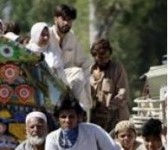Head in the sand
The only way we gain perspective about what is happening in our country is if we know what is happening outside our borders.
KALPANA SHARMA’s Second Take on the media’s non-coverage of stories in our neighbourhood. Pix: Refugees fleeing Swat valley.
Second Take
Kalpana Sharma
One of the casualties of the Indian media’s fixation with events within the country is the absence of foreign news coverage. Over the weeks following the election results and the cabinet formation, most news channels concentrated on speculative reporting about who would get which portfolio in "Team Manmohan". The exercise was reduced to a spectator sport. We the viewers watched and listened – and read the next morning – as the guesswork continued.
Over those two weeks, Sri Lanka went through its biggest crisis as the war against the LTTE ended but a far greater humanitarian crisis of lakhs of displaced people needed attention. There are an estimated 220,000 people in just one camp, Manik Farms, according to the UN, the largest single camp of displaced people anywhere in the world. According to some reports, conditions in the camp are terrible with people lacking basic facilities like water and sanitation at a time of the year when the heat and the humidity are impossible to bear. Women, children and the elderly are bearing the brunt of these conditions apart from the trauma of being displaced. By any stretch, this is a story that the Indian media should have followed even with limited access.
Yet, the live reports from Sri Lanka tended to dry up once the "operations" of the Sri Lankan army ended. The embedded journalists who reported then came back, or interviewed officials in Colombo. Even if official access to the camps is denied journalists and foreign aid agencies, surely there is a way of getting this news. A few reports did appear about Manik Farms after a group of foreign journalists accompanied the UN Secretary General when he visited Sri Lanka. Inevitably, during VIP visits you get no idea of the real conditions. People narrated the terrible conditions under which they had to live under the LTTE, a line that suited the Sri Lankan authorities. But no one would have dared complain about the conditions. Indian journalists tended to report only what they heard and saw. There was not an iota of scepticism or questioning in their reports. By way of contrast, the BBC reporter, who saw exactly the same things, was able to convey much more, such as the barbed wire surrounding the camp, the fact that people are not being allowed to return until they are cleared, that the elderly are suffering severe dehydration etc.
A mirror image of the Sri Lankan crisis is seen in Pakistan where lakhs of people have left the Swat region and are crowded into enormous tent cities. According to Save the Children, the conditions are beyond belief with scarce facilities and people living under tents in temperatures that touch 50 degrees Celsius. Basic facilities are lacking, children are succumbing to diseases, there is fear that there could be an outbreak of cholera and there is not enough medical help available. The Pakistani media, both print and electronic, is covering this crisis and unlike Sri Lanka, both media and aid agencies have access. As a result, we are getting an idea of the situation facing an incredible 2.5 million displaced people. One of the striking fact that emerges from these reports is that the majority, close to 80 per cent, have been taken in by the civilian population in homes or schools and a much smaller percentage is in the camps. Why are we not seeing adequate footage of this displacement? The only news about Pakistan that gets repeated is if there is a bomb blast but the condition of this enormous displacement that exceeds 1947 during Partition, has just not caught the interest of our media.
As a result, today despite multiple Indian news channels, viewers interested in foreign affairs have to watch BBC or CNN. There are practically no Indian channels that can provide foreign news unless it has a direct Indian connection. So once again, in a week when overseas stories included the incarceration of Aung San Su Kyi in Myanmar, the North Korean nuclear explosion, the on-going crisis in Sri Lanka, the continuous attacks and fighting in Pakistan as well as the people displaced from Swat, several Indian channels remained fixated with just one story: the attack on Indian students in Australia.
While some of the print media still provides space for foreign news, much of it tends to be either political news or flippant Hollywood gossip. As a result, there is no room for the human interest stories from our neighbouring countries that people would want to read.
So why is this even important? Do viewers/readers need to know what is happening around the world? What difference does it make to their lives? Isn’t the media’s job to report news that connects to the lives of their "market"? NDTV had a programme once called the World This Week. What happened to programmes like that? Have the marketing departments of these channels decided that viewers are not interested?
If you go by the redefined understanding of what constitutes news these days, one would be compelled to accept the latter proposition. But in an increasingly globalised world, where developments somewhere else are beginning to have a direct bearing on our lives, it is plain stupid of our media to adopt an ostrich-like approach to foreign news. The only way we gain perspective about what is happening in our country is if we know what is happening outside our borders.
